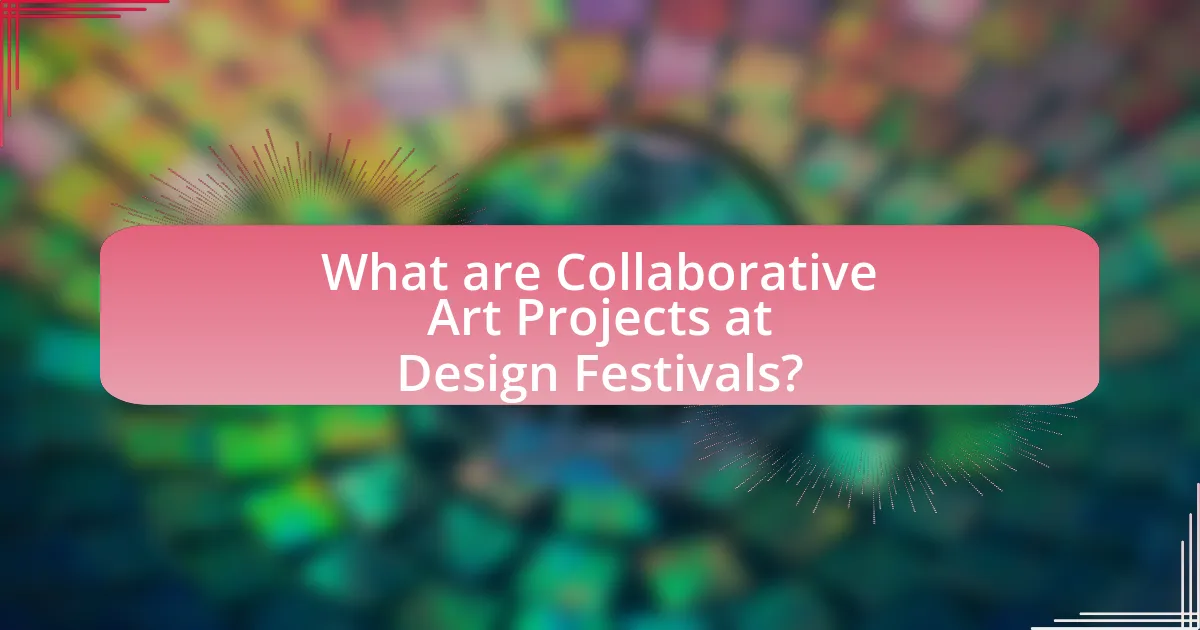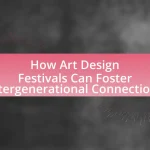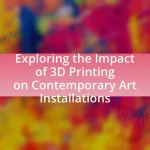Collaborative art projects at design festivals represent a growing trend where artists, designers, and community members unite to create works that reflect shared themes and engage the public. This article examines the evolution of these projects, highlighting their integration of technology, community involvement, and focus on sustainability. It discusses the significance of design festivals as platforms for collaboration, the characteristics of successful projects, and the common challenges faced. Additionally, it explores case studies that illustrate the impact of collaboration on addressing social and environmental issues, providing insights into best practices for enhancing these artistic endeavors.

What are Collaborative Art Projects at Design Festivals?
Collaborative art projects at design festivals are initiatives where multiple artists, designers, and community members work together to create artworks that reflect shared themes or concepts. These projects often aim to engage the public, foster creativity, and promote dialogue among participants and audiences. For instance, the Venice Biennale features collaborative installations that invite contributions from diverse artists, showcasing the power of collective creativity. Such projects not only enhance the festival experience but also highlight the importance of collaboration in contemporary art practices.
How have Collaborative Art Projects evolved in recent years?
Collaborative art projects have evolved significantly in recent years, increasingly integrating technology and community engagement. The rise of digital platforms has enabled artists to collaborate across geographical boundaries, allowing for diverse perspectives and innovative approaches. For instance, projects like “The Obliteration Room” by Yayoi Kusama have utilized interactive elements that invite audience participation, blurring the lines between artist and viewer. Additionally, design festivals have become key venues for these collaborations, showcasing works that emphasize sustainability and social issues, reflecting a growing trend towards art that engages with contemporary challenges. This evolution is evidenced by the increasing number of collaborative installations at major events, such as the Venice Biennale and Art Basel, which highlight the importance of collective creativity in addressing global themes.
What factors have contributed to the rise of these projects?
The rise of collaborative art projects at design festivals has been driven by increased community engagement, technological advancements, and a growing emphasis on sustainability. Community engagement fosters participation and collaboration among artists and audiences, enhancing the creative process and output. Technological advancements, such as social media and digital tools, facilitate broader outreach and collaboration across geographical boundaries. Additionally, the emphasis on sustainability encourages artists to work together on projects that address environmental concerns, reflecting contemporary societal values. These factors collectively contribute to the increasing prevalence and popularity of collaborative art projects in design festival settings.
How do these projects differ from traditional art exhibitions?
Collaborative art projects at design festivals differ from traditional art exhibitions primarily in their emphasis on participation and interaction. Unlike traditional exhibitions, which often showcase individual artists’ works in a static environment, collaborative projects invite audience engagement and co-creation, fostering a dynamic exchange between artists and viewers. For instance, events like the Venice Biennale have increasingly incorporated participatory elements, allowing visitors to contribute to the artwork, which contrasts with the conventional model where art is passively observed. This shift reflects a broader trend in contemporary art that values community involvement and collective creativity over individual authorship.
Why are Design Festivals important for Collaborative Art Projects?
Design festivals are important for collaborative art projects because they provide a platform for artists to connect, share ideas, and create together in a dynamic environment. These festivals foster collaboration by bringing together diverse talents and disciplines, which enhances creativity and innovation. For instance, events like the Venice Biennale and Milan Design Week showcase collaborative installations that often result from partnerships between artists, designers, and architects, demonstrating the value of interdisciplinary work. Additionally, design festivals attract a global audience, facilitating networking opportunities that can lead to future collaborations and projects.
What role do Design Festivals play in promoting collaboration?
Design festivals play a crucial role in promoting collaboration by serving as platforms where designers, artists, and industry professionals can connect, share ideas, and work together on projects. These events facilitate networking opportunities that encourage interdisciplinary partnerships, leading to innovative solutions and creative synergies. For instance, festivals like Milan Design Week and London Design Festival showcase collaborative installations that highlight the importance of teamwork in the creative process, demonstrating how diverse perspectives can enhance design outcomes. Additionally, studies have shown that participation in such collaborative environments can lead to increased creativity and problem-solving capabilities among participants, reinforcing the value of design festivals in fostering collaborative efforts.
How do festivals facilitate community engagement through art?
Festivals facilitate community engagement through art by providing a platform for collaborative artistic expression and interaction among diverse groups. These events often feature workshops, performances, and installations that invite participation from local artists and community members, fostering a sense of belonging and shared identity. For instance, the Edinburgh Festival Fringe encourages local performers to showcase their work alongside international acts, creating a vibrant cultural exchange that strengthens community ties. Additionally, studies have shown that participation in arts festivals can enhance social cohesion, as evidenced by research from the National Endowment for the Arts, which highlights increased community involvement and satisfaction among attendees.
What are the key characteristics of successful Collaborative Art Projects?
Successful Collaborative Art Projects are characterized by clear communication, shared vision, and mutual respect among participants. Clear communication ensures that all collaborators understand their roles and contributions, fostering an environment where ideas can be freely exchanged. A shared vision aligns the goals and creative direction of the project, enabling cohesive outcomes. Mutual respect among participants encourages diverse perspectives and enhances creativity, as individuals feel valued and empowered to contribute. These characteristics have been observed in various successful projects, such as the “The Obliteration Room” by Yayoi Kusama, where collaboration among artists and the public created a vibrant, interactive experience, demonstrating the effectiveness of these key traits.
What types of collaborations are most common in these projects?
The most common types of collaborations in collaborative art projects at design festivals include interdisciplinary partnerships, community engagement initiatives, and artist-organization collaborations. Interdisciplinary partnerships often involve artists working alongside designers, architects, and technologists to create innovative installations that blend various fields. Community engagement initiatives typically focus on involving local residents in the artistic process, fostering a sense of ownership and participation. Artist-organization collaborations frequently occur when artists partner with cultural institutions or businesses to enhance visibility and resources for their projects. These collaboration types are supported by numerous case studies showcasing successful outcomes, such as the “Design Miami” festival, which highlights the synergy between art and design through collaborative efforts.
How do artists and designers work together effectively?
Artists and designers work together effectively by establishing clear communication and shared goals. This collaboration often involves regular meetings to discuss ideas, feedback sessions to refine concepts, and the use of collaborative tools that facilitate real-time updates and brainstorming. For instance, successful projects at design festivals, such as the “Design Miami” event, showcase how artists and designers co-create by merging artistic vision with functional design, resulting in innovative installations that resonate with audiences. This synergy not only enhances creativity but also leads to more impactful outcomes, as evidenced by the increased audience engagement and critical acclaim received by collaborative projects.
What insights can be gained from case studies of Collaborative Art Projects?
Case studies of Collaborative Art Projects reveal insights into community engagement, creative processes, and the impact of collaboration on artistic outcomes. These projects often demonstrate how diverse perspectives enhance creativity, as seen in the “The People’s Choice” project at the 2019 Venice Biennale, where artists collaborated with local communities to create art that reflected shared experiences. Additionally, they highlight the importance of interdisciplinary approaches, as evidenced by the “Art and Science” collaboration at the 2020 Design Festival, which merged artistic expression with scientific inquiry, resulting in innovative installations. Furthermore, these case studies illustrate the potential for social change, as collaborative art can foster dialogue and address societal issues, exemplified by the “Mural Project” in Detroit, which transformed public spaces and engaged residents in discussions about urban identity.
How do specific projects illustrate the impact of collaboration?
Specific projects illustrate the impact of collaboration by demonstrating how diverse skill sets and perspectives can enhance creativity and innovation. For example, the “The Hive” installation at the 2016 Venice Architecture Biennale brought together architects, artists, and engineers to create an immersive environment that engaged visitors in a dialogue about sustainability. This project showcased how collaborative efforts led to a more complex and engaging experience than any single discipline could achieve alone. Additionally, the “Co-Lab” initiative at the 2019 London Design Festival involved multiple artists working together to produce a series of interactive installations, highlighting the synergy created through teamwork, which resulted in a richer exploration of themes such as community and identity. These examples underscore that collaboration not only fosters unique artistic expressions but also addresses complex societal issues more effectively.
What lessons can be learned from successful case studies?
Successful case studies reveal that collaboration enhances creativity and innovation in art projects. For instance, the collaborative art project “The Obliteration Room” by Yayoi Kusama demonstrated how collective participation transformed a blank space into a vibrant, interactive environment, showcasing the power of community engagement. Additionally, case studies indicate that clear communication and shared goals among collaborators lead to more effective project outcomes, as seen in the “Design for the Other 90%” exhibition, which united diverse designers to address global challenges. These examples underscore the importance of collaboration, communication, and community involvement in achieving impactful results in art projects at design festivals.
How do these projects address social or environmental issues?
Collaborative art projects at design festivals address social and environmental issues by fostering community engagement and promoting sustainability. These projects often involve local artists and residents, creating a platform for dialogue about pressing social concerns, such as inequality and environmental degradation. For instance, initiatives like community murals or installations made from recycled materials not only beautify public spaces but also raise awareness about environmental conservation and social justice. Evidence of their impact can be seen in increased community participation and heightened public discourse surrounding these issues, demonstrating the effectiveness of art as a catalyst for social change.
What challenges do Collaborative Art Projects face at Design Festivals?
Collaborative art projects at design festivals face challenges such as coordination difficulties, differing artistic visions, and resource limitations. Coordination among multiple artists can lead to conflicts in scheduling and communication, which may hinder project execution. Differing artistic visions can create tension, as artists may have unique interpretations and styles that clash, complicating the collaborative process. Additionally, resource limitations, including funding, materials, and space, can restrict the scope and quality of the projects, making it difficult to achieve the intended artistic outcomes. These challenges are documented in various case studies that highlight the complexities of collaboration in artistic environments.
How can logistical issues affect project outcomes?
Logistical issues can significantly hinder project outcomes by causing delays, increasing costs, and compromising quality. For instance, if a collaborative art project at a design festival faces transportation delays for materials, the project timeline may be disrupted, leading to rushed work and subpar results. A study by the Project Management Institute found that 39% of projects fail due to inadequate planning and logistical challenges, highlighting the critical role logistics play in achieving successful project completion.
What are common misunderstandings about collaboration in art?
Common misunderstandings about collaboration in art include the belief that collaboration diminishes individual creativity and that it is solely about compromise. Many artists think that working together means sacrificing their unique vision, but in reality, collaboration can enhance creativity by combining diverse perspectives and skills. Additionally, some assume that collaboration is only effective when all parties agree, overlooking the fact that productive conflict and differing opinions can lead to innovative outcomes. Research indicates that collaborative projects often result in richer artistic expressions, as seen in various design festivals where artists merge their distinct styles to create compelling works.
What best practices can enhance Collaborative Art Projects at Design Festivals?
Best practices that can enhance Collaborative Art Projects at Design Festivals include fostering open communication among participants, establishing clear goals, and encouraging diverse artistic contributions. Open communication ensures that all artists feel valued and can share their ideas freely, which enhances creativity and collaboration. Establishing clear goals provides a shared vision that aligns the efforts of all participants, making the project more cohesive and focused. Encouraging diverse artistic contributions brings varied perspectives and techniques, enriching the final outcome and appealing to a broader audience. These practices have been shown to lead to more successful and impactful collaborative projects, as evidenced by case studies from festivals like the Venice Biennale and Burning Man, where structured collaboration has resulted in innovative art installations.
How can artists and organizers foster effective collaboration?
Artists and organizers can foster effective collaboration by establishing clear communication channels and shared goals. Clear communication ensures that all parties understand their roles and expectations, which is essential for aligning creative visions. For instance, regular meetings and collaborative platforms can facilitate ongoing dialogue, allowing artists and organizers to address challenges and brainstorm ideas together. Additionally, setting shared goals helps to unify efforts and create a cohesive project direction, as evidenced by successful collaborative art projects at design festivals where defined objectives led to innovative outcomes.
What strategies can be employed to engage festival audiences?
To engage festival audiences, organizers can implement interactive experiences, such as workshops and live demonstrations, which foster participation and connection. Research indicates that hands-on activities significantly enhance audience engagement by allowing attendees to actively contribute to the artistic process, thereby creating a sense of ownership and investment in the event. For instance, collaborative art projects at design festivals have shown that when audiences are invited to co-create, their emotional and social connections to the festival increase, leading to higher satisfaction and likelihood of return attendance.















